Abstract
The sulfonylurea herbicide chlorsulfuron and the imidazolinone herbicide imazaquin were shown to be noncompetitive and uncompetitive inhibitors, respectively, of purified acetolactate synthase from barley (Hordeum vulgare L.) with respect to pyruvate. From double-reciprocal plots of the time-dependent biphasic inhibition by chlorsulfuron, an initial apparent inhibition constant of 68 nanomolar was calculated (a 0 to 4 minute assay was used for the initial inhibition), and a final steady-state dissociation constant of 3 nanomolar was estimated. The corresponding constants for imazaquin were 10 and 0.55 micromolar. Specific binding of [14C]chlorsulfuron and [14C]imazaquin to purified acetolactate synthase from barley and partially purified enzyme from corn (Zea mays L.) could be demonstrated by gel filtration and equilibrium dialysis. Evidence is presented that the binding of the inhibitors to the enzyme follows the previously described mechanism of slow reversibility once excess inhibitor has been removed. However, after formation of the slowly reversible complex and subsequent dissociation, both chlorsulfuron and imazaquin seem to permanently inactivate acetolactate synthase. These results add a new feature to the mode of action of these herbicides with respect to their high herbicidal potency.
Full text
PDF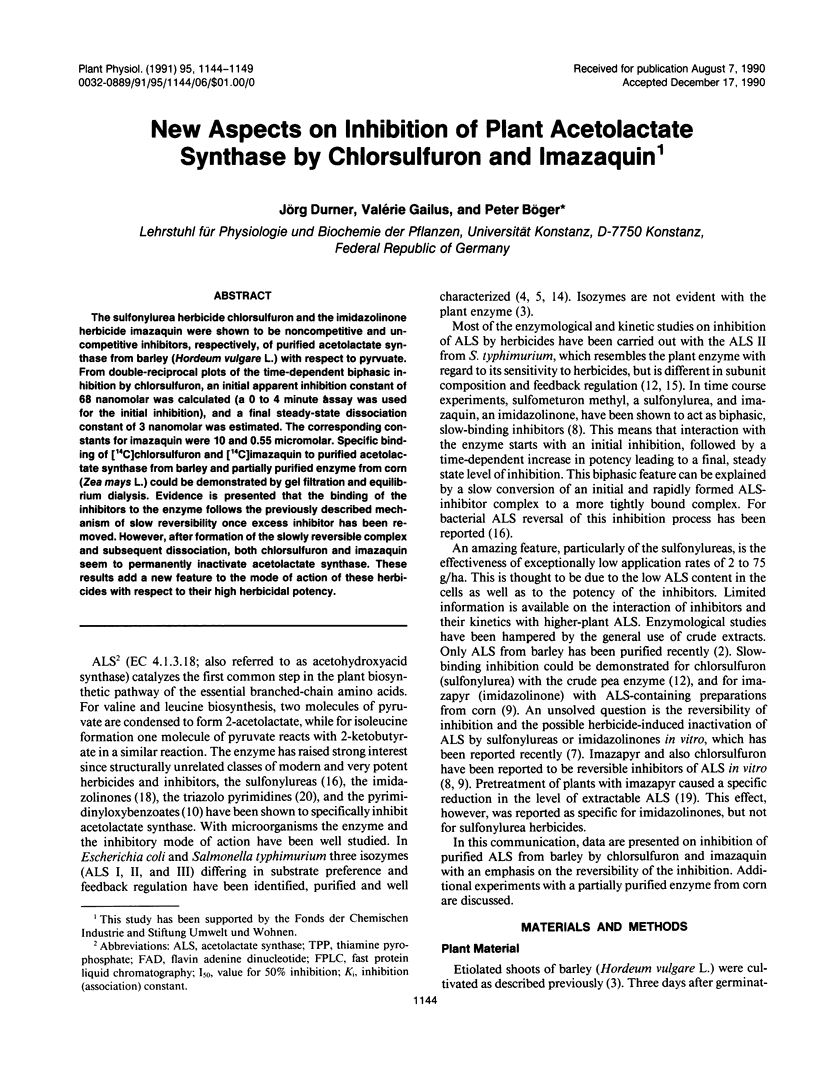
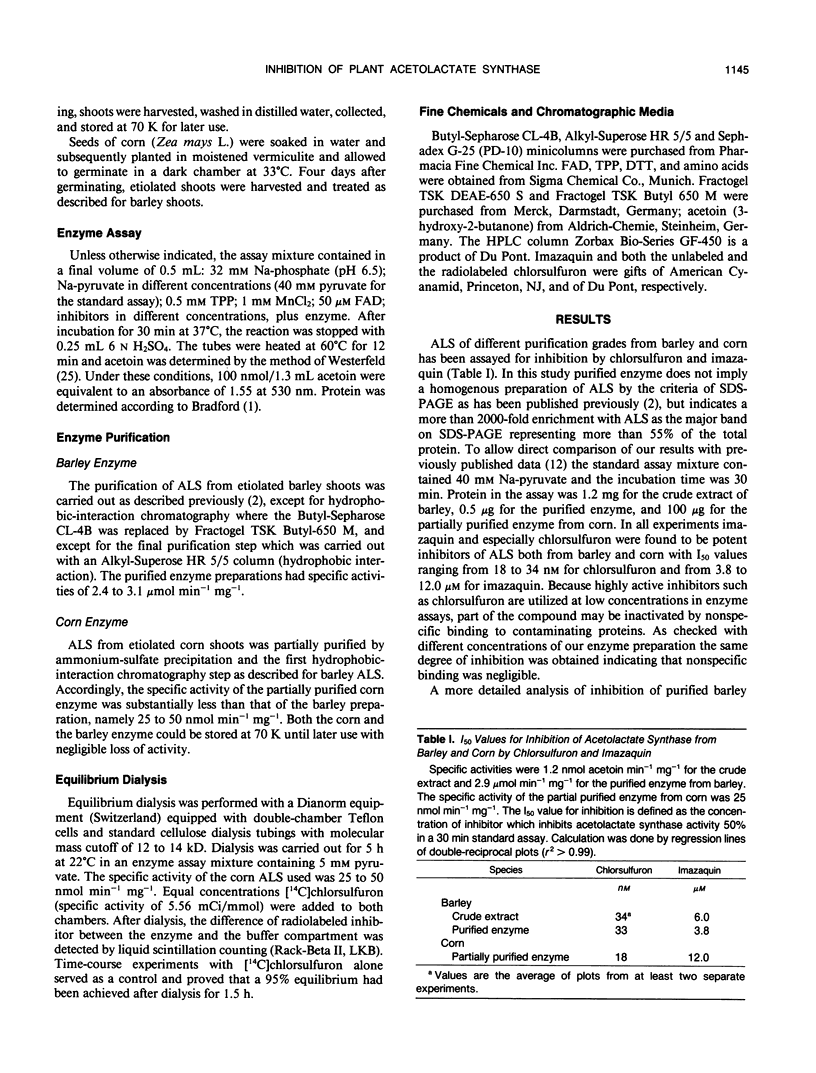
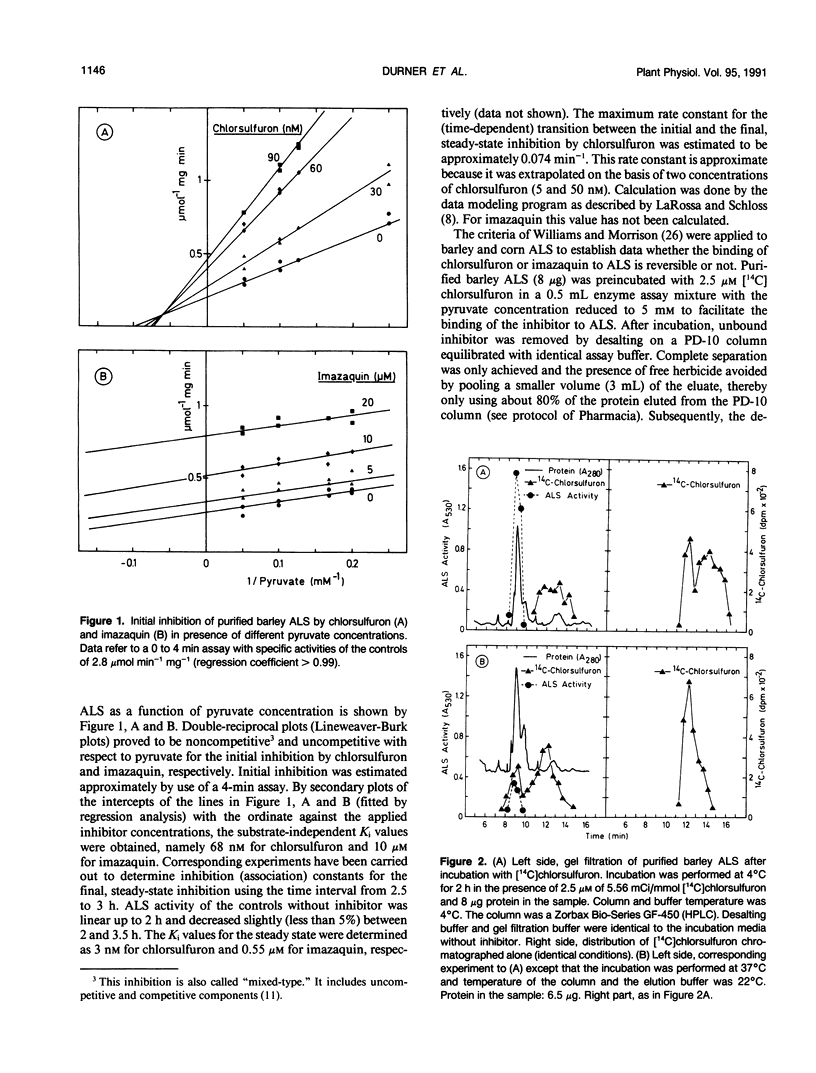
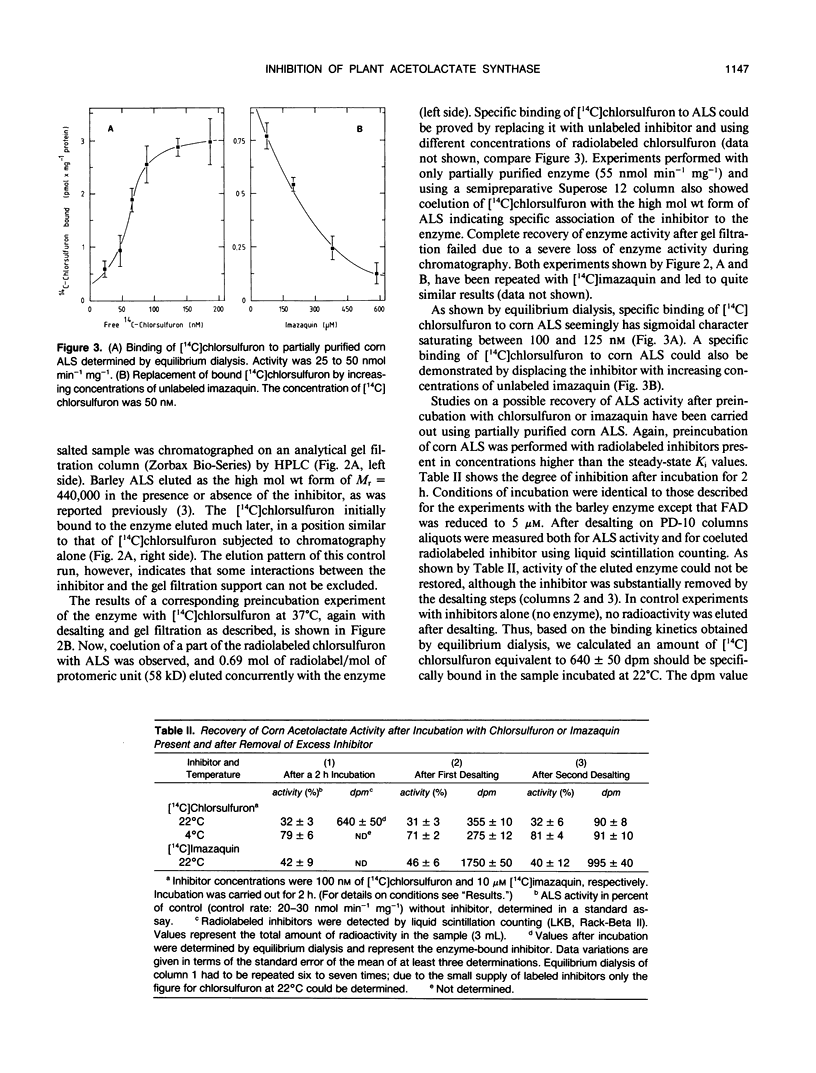
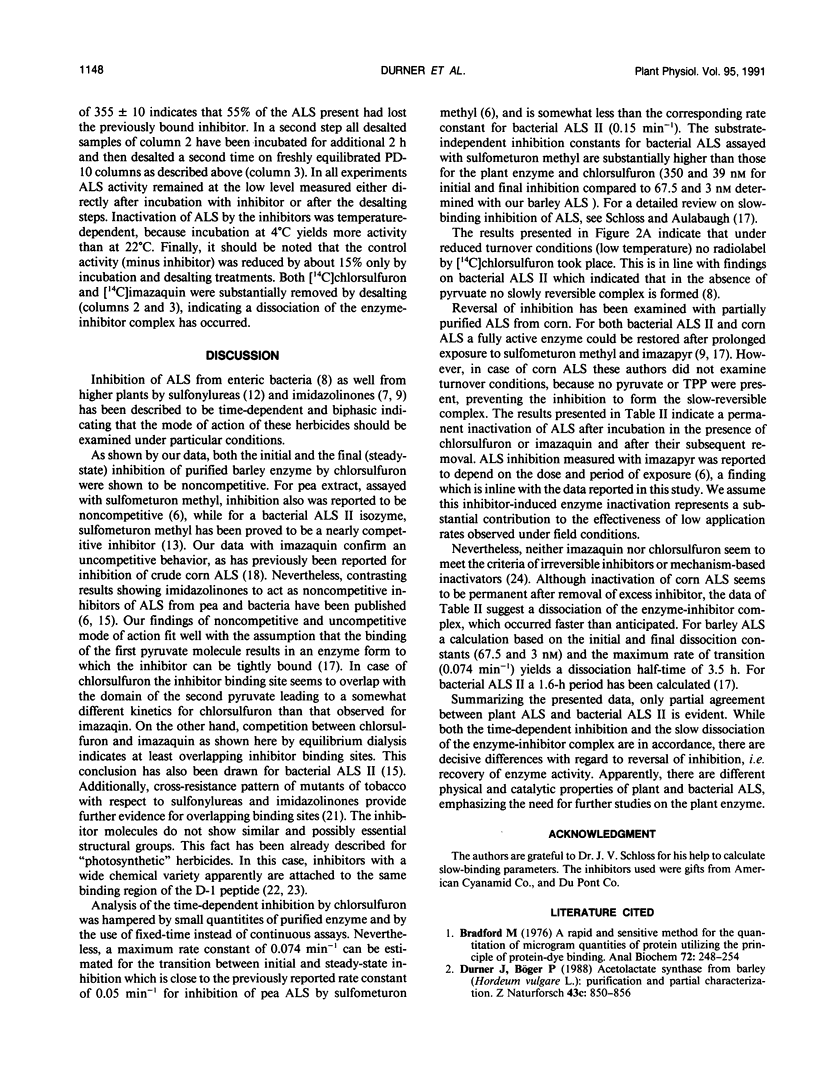
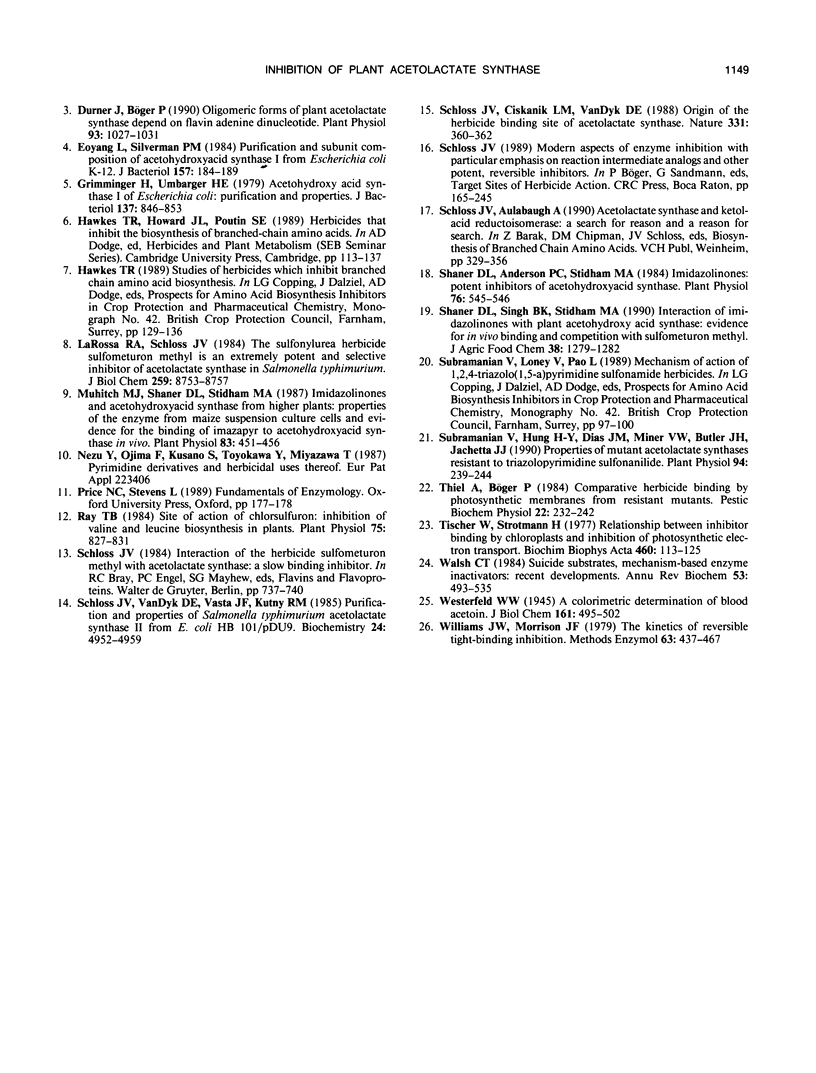
Selected References
These references are in PubMed. This may not be the complete list of references from this article.
- Bradford M. M. A rapid and sensitive method for the quantitation of microgram quantities of protein utilizing the principle of protein-dye binding. Anal Biochem. 1976 May 7;72:248–254. doi: 10.1006/abio.1976.9999. [DOI] [PubMed] [Google Scholar]
- Durner J., Böger P. Oligomeric forms of plant acetolactate synthase depend on flavin adenine dinucleotide. Plant Physiol. 1990 Jul;93(3):1027–1031. doi: 10.1104/pp.93.3.1027. [DOI] [PMC free article] [PubMed] [Google Scholar]
- Eoyang L., Silverman P. M. Purification and subunit composition of acetohydroxyacid synthase I from Escherichia coli K-12. J Bacteriol. 1984 Jan;157(1):184–189. doi: 10.1128/jb.157.1.184-189.1984. [DOI] [PMC free article] [PubMed] [Google Scholar]
- Grimminger H., Umbarger H. E. Acetohydroxy acid synthase I of Escherichia coli: purification and properties. J Bacteriol. 1979 Feb;137(2):846–853. doi: 10.1128/jb.137.2.846-853.1979. [DOI] [PMC free article] [PubMed] [Google Scholar]
- LaRossa R. A., Schloss J. V. The sulfonylurea herbicide sulfometuron methyl is an extremely potent and selective inhibitor of acetolactate synthase in Salmonella typhimurium. J Biol Chem. 1984 Jul 25;259(14):8753–8757. [PubMed] [Google Scholar]
- Muhitch M. J., Shaner D. L., Stidham M. A. Imidazolinones and acetohydroxyacid synthase from higher plants: properties of the enzyme from maize suspension culture cells and evidence for the binding of imazapyr to acetohydroxyacid synthase in vivo. Plant Physiol. 1987 Feb;83(2):451–456. doi: 10.1104/pp.83.2.451. [DOI] [PMC free article] [PubMed] [Google Scholar]
- Ray T. B. Site of action of chlorsulfuron: inhibition of valine and isoleucine biosynthesis in plants. Plant Physiol. 1984 Jul;75(3):827–831. doi: 10.1104/pp.75.3.827. [DOI] [PMC free article] [PubMed] [Google Scholar]
- Schloss J. V., Van Dyk D. E., Vasta J. F., Kutny R. M. Purification and properties of Salmonella typhimurium acetolactate synthase isozyme II from Escherichia coli HB101/pDU9. Biochemistry. 1985 Aug 27;24(18):4952–4959. doi: 10.1021/bi00339a034. [DOI] [PubMed] [Google Scholar]
- Shaner D. L., Anderson P. C., Stidham M. A. Imidazolinones: potent inhibitors of acetohydroxyacid synthase. Plant Physiol. 1984 Oct;76(2):545–546. doi: 10.1104/pp.76.2.545. [DOI] [PMC free article] [PubMed] [Google Scholar]
- Subramanian M. V., Hung H. Y., Dias J. M., Miner V. W., Butler J. H., Jachetta J. J. Properties of mutant acetolactate synthases resistant to triazolopyrimidine sulfonanilide. Plant Physiol. 1990 Sep;94(1):239–244. doi: 10.1104/pp.94.1.239. [DOI] [PMC free article] [PubMed] [Google Scholar]
- Tischer W., Strotmann H. Relationship between inhibitor binding by chloroplasts and inhibition of photosynthetic electron transport. Biochim Biophys Acta. 1977 Apr 11;460(1):113–125. doi: 10.1016/0005-2728(77)90157-8. [DOI] [PubMed] [Google Scholar]
- Walsh C. T. Suicide substrates, mechanism-based enzyme inactivators: recent developments. Annu Rev Biochem. 1984;53:493–535. doi: 10.1146/annurev.bi.53.070184.002425. [DOI] [PubMed] [Google Scholar]
- Williams J. W., Morrison J. F. The kinetics of reversible tight-binding inhibition. Methods Enzymol. 1979;63:437–467. doi: 10.1016/0076-6879(79)63019-7. [DOI] [PubMed] [Google Scholar]


